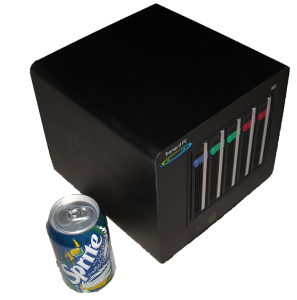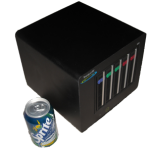So I had a bit of experimentation with the BBS2. I had purchased the storage drives (2x Samsung HD103UJ SpinPoint F 1TB Hard Drive) but had decided that I did not want the OS to be installed on the raid. So after scrounging a 160GB maxtor off a friend I installed Ubuntu Jaunty and successfully got the raid going, mounted and working. However, at the time Jaunty was only in beta, and there seemed to be some stability problems (which would be expected), over 48 hours I had 2 kernel panics that completely halted the system. I was not able to determine the cause.
Realising that I need this to be as stable as I can, I then opted for Ubuntu Hardy LTS, which has been around for a year now and would be much more stable, plus it’s supported with fixes for the next couple of years as well. Leaving the sever to run, I then noticed that the core temperature was getting a lot higher than expected, the Maxtor Diamond Max Plus 9, was running at near to 50 degrees and when the Samsung drives were moved adjacent to the Maxtor, their temperature went up to 42-45 degrees, this is within the operating temperature but I didn’t like the idea of them running at 10 degrees above their normal operating temperature.
So I purchased an old 8Gb Corsair Voyager GT from the same said friend, which has a 10 year replacement guarantee, stuffed it in a free USB port, installed Ubuntu Hardy to that and it works a treat. Bootup time is as fast if not faster than when installed on the Maxtor SATA drive, it’s plenty big enough for the OS, I mounted it with noatime, nodiratime, and the drives are sitting nicely at about 33 degrees c.
The BBS is acting as a print server, samba server for the wife’s Vista laptop, NFS server for me, has apache installed and exposed as http and https for providing my svn server (still to do). All the data is on the raid, which is currently defined as raid 5, but only has two drives and is therefore mirrored, but as my storage needs increase, I now have 3 free slots, bring the system to a maximum of 4Tb if needed (maintaining the current 1Tb drives). If I need more than that I can even purchase a second drive only box to get another 5 bays attached by eSata.
Some useful resources and tips when setting up the server
Setting up automatic updates in Ubuntu Hardy
Adding users, new users to groups and new groups
Creating self signed certificates for apache
Getting system temperature and sensors information:
- apt-get install lm-sensors, run sudo sensors-detect and answer yes to everything. Reboot, then run sensors to see all the info.
- apt-get install hddtemp don’t bother running as a daemon, run sudo hddtemp /dev/sd[e.g. a].
Easily enabling remote access for Cups:
- install lynx (the command line browser)
- run lynx localhost:631
- choose administration menu, then Basic Server Settings, Check Share published printers and allow remote administration. Change Settings and quit. Then in your nice gui browser goto machine name :631 and add printers, etc.
Install ebox it’s a great web admin interface, add the first line to /etc/apt/sources.list then run the second:
-
deb http://ppa.launchpad.net/ebox/ppa/ubuntu hardy main
-
sudo apt-key adv --recv-keys --keyserver keyserver.ubuntu.com 274b5881e00011fb79e2eae15f99a088342d17ac
Install the ubuntu profiles for screen (screen allows you to start multiple bash sessions / run applications and they stay resident so you can re-attach to them in case of network dropout it’s cli based and can be run in an SSH connection), add the first line to /etc/apt/sources.list then run the second
-
deb http://ppa.launchpad.net/screen-profiles/ppa/ubuntu hardy main
-
sudo apt-key adv --recv-keys --keyserver keyserver.ubuntu.com a42a415b4677d2d22eb05723cf5e7496f430bba5


11 replies on “Installing Ubuntu on the BBS2”
Hi Matt,
Some very interesting stuff on your blog about the BBS2. I’ve been looking for a replacement home server for a while and this unit seems to be the most suitable of any that I have seen. I’m current running an old small form factor Compaq PC (P3 733MHz with 512 Mb RAM) with three HDs squeezed into it (2 running in RAID 1) and OpenFiler installed as the OS. It’s working fine but consumes about 60W and OpenFiler isn’t so open when it comes to documentation.
The ebox tip seems a good one – did you consider using webmin? I used it years back but I’m not sure if it would require more work to setup.
Chris.
I tried webmin in the ubuntu vm and as well as the UI not being as nice and simple as ebox, I had problems with it expecting config files to be in different places. e.g when I tried to create the raid with webmin, it put the mdadm config file in etc, where as ubuntu uses a mdadm sub folder. I did not investigate if this was easy to change or not, but ebox seems to be more ubuntu orientated.
To make the perfect box for me, I’d love ubuntu to support zfs in the kernel. It seems this maybe a pipe dream at the moment due to licensing but as soon as I can get check-summed raid going I’d be happy that the box was “data secure”.
I’ve just got my BBS2 and have installed Ubuntu 9.04. All is fine, but the fan doesn’t seem to be variable in speed and the cpu scaling didn’t work “out of the box”. Did you have have any problems getting the fan to work as expected? My box got a little warm as a result 🙂
I’ve just had a problem with mine where the temp, buzzer kept on going off, even when the temperature was fine. After talkind to tranquil, they suggested re-seating the fan, which so far (about 36hrs) has fixed the problem.
I gather there are different fans shipped in the past that had speed detection etc, but my Category ‘D’ (written in pen on the sticker 🙂 ) is one of the fluid dynamic baring types and as it’s so quite it just runs full pelt all the time.
This is pretty average for my box:
Chip Temp: +39.0 C
CPU Temp: +54.0 C
Sys Temp: +47.0 C
I didn’t want to venture into jaunty as I port forwarding couple of services so I went with the hopefully “fully” secure LTS edition.
Thanks for all your comments guys…
hi matt,
my bbs2 arrived yesterday (woo!) and I am now trying to install ubuntu onto a USB stick (I thought that sounded a great idea). I was wondering how you got Ubuntu installed onto a USB stick ~ I have triedUNbootin from windoze but so far without success…
Thanks for making this available…
Glad you are finding the information of use. I used the create bootable USB drive option in ubuntu System > Adminsitration > USB Startup Disk Creator, I am not sure, but the option may be available on the Live CD.
Dang nabbit. I tried booting to the Jaunty live (desktop) CD and using that tool to make a bootable USB stick > same “Boot Error” message. I went into the bbs2 bios to load the optimal settings (just in case) but still no joy (with or without the 3 x blank 1TB green HDDs installed).
I am wondering if the host PC used to make the USB stick (AMD64) sets the USB system incorrectly for the target ATOM system?
Anyway, can you suggest a good site / forum to use to get help? Otherwise I’ll have to go out and buy a USB cd drive…
P.S. Have you opened your case?
Just in case people come back to this page, my USB boot issue was caused by one of (a) bios setting for treating USB drives as fixed (b) misc other bios boot order settings or (c) selecting the advanced install option to put GRUB on the removable drive (and then having to edit the file afterwards). I am fairly sure (c) was important but I am not sure how much (a) or (b) matter. I need to investigate what the BIOS settings mean.
matt ~ what are your BIOS boot settings?
Also ~ I am now building the RAID array from 3xWD 1TB Caviar Green and it is going to take about 10 hours! This seems slow to me, any comments?
I used the same setup, 3 x 1Tb Caviar Greens and it took about the same amount of time to setup. It’s an overnight job for sure.
@Chris, cool, good news it’s not just me…
Now if only I could get the samba config right so that I can share the raid array with the vista laptop and xp desktop ~ sounds very similar to what you have matt, can you point me to a good guide for hardy heron?
I love this piece of kit and am frustrated by my almost-linux-newbie status *sigh*
Sorry for the delay, was on my hols.
Samba can’t get much simpler than this 🙂 http://www.jonathanmoeller.com/screed/?p=181